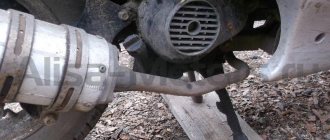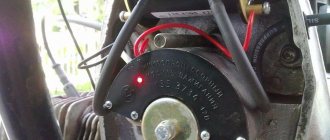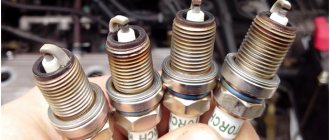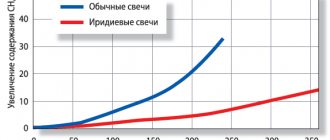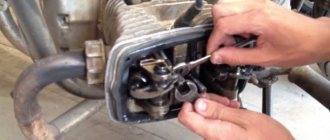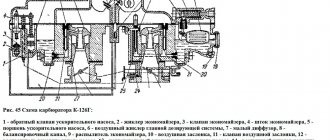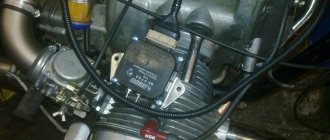Before answering the question of why the candles are black, you need to decide how exactly they turned black . After all, it depends on which direction to search. In particular, the candles can turn black all together, or maybe only one or two of the set. Also, the candle may turn black only on one side, or perhaps along its entire diameter. There are also so-called “wet” and “dry” carbon deposits.
It should be noted that the speed of appearance and nature of carbon deposits directly depends on existing faults (if any):
- Carbon deposits on new spark plugs begin to form after at least 200-300 km. Moreover, it is advisable to drive along the highway at approximately the same speed and engine load. This way the spark plugs will work in optimal mode, and it will be possible to more objectively assess the condition of the car’s components.
- The amount and type of soot depends on the quality of the fuel used. Therefore, try to refuel at trusted gas stations, and not drive with gasoline or similar mixtures. Otherwise, it will be difficult to establish the real cause of the appearance of soot (if it occurs).
- In a carburetor engine, the idle speed must be set correctly.
Now let's move directly to the question of why black soot appears on the spark plugs. There may be 11 main reasons :
- If you notice blackening on only one side, then most likely this is caused by a burnt-out valve. That is, carbon deposits on the spark plug fall on the side electrode from below (and not on the central one).
- The cause of black spark plugs may be a burnt-out valve. The situation is similar to the previous one. Carbon deposits may penetrate the bottom electrode.
- An incorrectly selected glow rating of a spark plug causes not only damage to it during further use, but also uneven blackening at first. If the mentioned number is small, then the shape of the soot cone will change. If it is large, then only the top of the cone will turn black, and the body will be white.
“Dry” carbon deposits on a candle
As a rule, when the ignition is set late and the air-fuel mixture is rich, the following consequences arise:
- misfires (error P0300 appears on injection engines);
- problems starting the engine;
- unstable engine operation, especially at idle, and as a result, increased vibration levels.
Next, we will tell you how to eliminate the listed faults and how to clean the spark plugs.
Causes of black soot
Before finding out the reason why the candles turned black, it is important to understand how this happened, how many of them turned black (one, two or all at once), on which side the soot formed (on one, two or all around), how “dry” it is. or "wet".
This determines how to diagnose and what to pay attention to first.
It is also important to understand that some malfunctions contribute to the rapid formation of black soot and affect its character, and some chronic engine problems can change the condition of the spark plugs gradually.
But before you indulge in various breakdowns, make sure:
- Is the idle speed set correctly, especially for carburetor engines?
- Are you driving the car correctly, are you not overloading the engine with high speeds, what is the cruising speed on a flat road. Those. It is important to make sure that the machine was operated as correctly as possible and the spark plugs worked in their optimal mode.
- If the conditions listed in paragraph 2 are met, the appearance of the first slight deposit on new spark plugs will occur after 150 - 200 km. If earlier, and it is clearly black, then you should sound the alarm.
- Where do you refuel and what kind of fuel do you put in the tank? If you often drive on gasoline, then don’t be surprised by black spark plugs, but you won’t be able to really find out why they became that way. Also, in the cylinder, at a temperature of about 500 0 C, low-quality gasoline does not burn completely, which also causes black soot on the spark plugs.
- Late ignition - uniform black carbon deposits form on the spark plug.
- Malfunctions in the ignition system (carburetor engine). The following malfunctions can lead to incomplete combustion of fuel in the cylinders as a result of a weak spark or to failures in its formation and, as a result, the appearance of black soot, these are: faulty ignition coil and spark plugs themselves, poor insulation of high-voltage wires, ignition angle is set incorrectly, breakdown of the distributor runner and the cover itself.
- Valve burnout. Carbon deposits can form on both the side and bottom electrodes, i.e. from a certain side. Also, incorrectly adjusted thermal valve clearances can lead to incomplete combustion of fuel in the cylinders and, as a result, the appearance of carbon deposits on the spark plugs.
- Enriched air-fuel mixture. This case is characterized by a black velvety soot without oil stains.
Applies to both carburetor and injection engines. As for the first, the formation of black carbon deposits on the spark plugs can be influenced by: the float touching the chamber walls or its depressurization, incorrect fuel level in the carburetor, a strongly protruding fuel pump drive pusher, which creates high fuel pressure in the system, or a depressurized needle valve. As for the injector, pay attention to the condition of the injectors, which, as a result of depressurization, can constantly flood the spark plugs with fuel. And also on the MAF (mass fuel flow sensor). It analyzes the mixture and sends data to the ECU. If it is faulty, the ECU will give incorrect commands to the injectors. - Incorrect heat rating. One of the criteria for choosing spark plugs is the heat rating. The higher it is, the less the candle heats up and vice versa. A spark plug with an incorrectly selected heat rating for a particular engine may not only blacken unevenly, but also fail.
- Low compression. In the cylinder where the black spark plug was found, check the compression.
- The power mode economizer ball valve (for carburetors) has failed. As a result of this malfunction, a large amount of fuel enters the cylinders even when it is not needed, for example, during normal engine operating conditions.
- High pressure in the fuel rail (for injectors). Fuel regulator is broken.
- The air damper actuator and air filter have failed. Check the latter and replace if necessary.
- Notice the smoke coming from the exhaust pipe.
If the engine is running on a rich fuel mixture or late ignition is observed, this will manifest itself:
- High level of engine vibration as a result of its unstable operation, especially at low speeds.
- The appearance of error P0300 on the instrument panel of an injection car and misfires on the carburetor.
- Poor engine starting.
The most dangerous thing for spark plugs is oil getting on them and simultaneously overheating. This will lead not only to their rapid blackening, but also to failure of the electrodes - they cannot be repaired.
Why does the spark become weak?
There are several reasons why an Alpha moped may have a weak spark. Failures should be looked for in the following systems:
- generator;
- spark plug;
- battery;
- distributor;
- ignition coil.
When diagnosing, you need to move forward sequentially, checking each system until the fault is found.
Generator
If there is a spark on the Alpha moped, but it is weak, you need to start by checking the generator. This is a system that is responsible for creating an electrical impulse to start the motor. It is necessary to inspect the device and contacts. If there are visible defects (for example, the wire is exposed or the contact is poor), they need to be eliminated. You need to look for damage on the coil. If they are, the unit needs to be replaced. Sometimes you have to install a new generator.
Spark plug
A weak spark in an Alpha moped may be due to improper operation of the spark plug. If everything is normal with the generator, you need to inspect this element. If there are cracks or other defects, the spark plug needs to be replaced.
If there is carbon on the candle, it needs to be removed. If the color of the insulator has changed, become black or, conversely, light, you need to correctly adjust the fuel mixture ratio. The proportion of air and gasoline must be correct. If you can carefully clean the spark plug, you can use it again or carry it with you as a spare part.
Battery
Another reason for a weak spark in an Alpha moped can be a low battery charge. Two-wheelers of this model use batteries with a charge of 12 V. But if it turns out that the battery does not produce higher than 9 V, it needs to be properly serviced or replaced. The battery must be charged using a special device. If the wrong device is used, the battery will quickly fail. If the battery charge is low, there may be a weak spark on the spark plug of the Alpha moped. If it is discharged, it may be difficult to start the engine. There may be no spark at all.
Black carbon deposits on spark plugs, causes
Black carbon deposits on the electrodes and insulators are one of the most common spark plug problems.
Its appearance indicates certain problems in the operation of the car engine and its systems. In most cases, black soot is the remnants of an over-enriched fuel mixture that have not burned in the combustion chamber. Constant use of spark plugs with black soot leads to interruptions in their operation at best and complete failure at worst. This is reflected in engine operation by the appearance of dips and jerks, unstable idling (the engine “troits”), “shooting” at the muffler, loss of power and throttle response, and increased fuel consumption.
There are not so many reasons for the appearance of black carbon deposits on the spark plugs of a carburetor engine of a passenger car (for example, VAZ 2108, 2109, 21099, 2105, 2107). Below is a list of them in relation specifically to carburetor engines of VAZ 2108, 2109, 21099, 2105, 2107.
Reasons for the appearance of black carbon deposits on the spark plugs of a carburetor engine
— Reasons related to the carburetor and power system
Black carbon deposits on spark plugs are the result of a highly enriched fuel mixture, the residues from incomplete combustion of which are deposited on the electrodes and insulator of the spark plugs. This can lead to:
Increased fuel level in the carburetor float chamber (“overflow”)
The level is not adjusted correctly, the needle shut-off valve is not sealed, the float(s) are not sealed, the float(s) touches the walls of the float chamber, the fuel pump creates excess pressure (the drive pusher protrudes strongly).
Measuring the fuel level in the float chamber of the carburetor 2108, 21081, 21083 Solex
Measuring the protrusion of the VAZ fuel pump pusher
Wear or leakage of the power mode economizer ball valve
Excess fuel enters the engine not only in power modes, when the economizer should be turned on, but also in all other modes.
Economizer device for power modes of carburetor 2108, 21081, 21083 Solex
Clogged air jets of the main dosing systems
The fuel mixture becomes over-rich because not enough air is supplied to it.
Air jets, fuel jets, emulsion tubes and GDS wells of the Solex carburetor
The fuel mixture “quality” screw is not adjusted correctly
The adjustment was made in the direction of re-enrichment of the fuel mixture.
Screws for adjusting the “quality” and “quantity” of the fuel mixture of the Solex carburetor
The air filter is very dirty
In this case, the balance of fuel and air again shifts towards an excess of fuel.
Heavily contaminated car engine air filter element
— Reasons related to the ignition system
The ignition timing is not set correctly
Most likely the ignition is too early. The fuel mixture ignites too early and does not burn completely.
Ignition alignment mark on flywheel
The high-voltage wires, the cover or the “slider” of the distributor are “broken”
Current leakage through “broken” parts of the ignition system reduces the power of the spark or leads to its termination. The fuel mixture does not burn efficiently.
Ignition coil is faulty
The ignition coil may leak current through a crack in the cover. The consequences are similar to those described above.
The spark plugs themselves are faulty
The glow number of the spark plugs does not correspond to the engine, the gap between the spark plug electrodes is small, the spark plug is internally defective.
The listed malfunctions lead to interruptions in spark formation, a weak spark between the electrodes of the spark plugs and, accordingly, to poor and inefficient combustion of the fuel mixture. As a result, the engine “troubles” or does not start, the electrodes of the spark plugs are black.
— Reasons related to engine malfunction
Severe wear on piston rings
There is no compression in the cylinders on the compression stroke. Without the necessary pressure in the combustion chambers, the fuel mixture burns poorly and deposits black soot on the spark plugs.
Problems with the engine valve train
The valves are not sealed and their thermal clearances are not adjusted.
These reasons lead to inefficient combustion of the fuel mixture, its burning out in the intake manifold and, accordingly, the deposition of black deposits on the electrodes of the spark plugs.
Notes and additions
— If the engine and all its systems are operating normally, carbon deposits on the spark plugs are brown (the range of brown can be from light brown to dark brown).
1↑ Topic from Alexander91 06-05-2012 18:40:16
- Alexander91
- Newbie
- Inactive
- Registered: 06-05-2012
- Messages: 10
Topic: Ural did not start because there was a very weak spark
Hello dear forum users! I have the following question for you, I recently bought a Ural, I don’t know the exact model, it was produced in 1989, it wouldn’t start because there was a very weak spark, what I didn’t do - I bought a new breaker, a Conder coil, installed everything, there’s still a spark weak, then I started changing the PP, and after replacing the relay it started for some reason, for about 2 days it started and drove, then I started it and drove off, for some reason it suddenly stalled and that’s it, wouldn’t start, drove home, played around with the carbs and air filter, started, worked again and stalled, and still - it doesn’t even catch anymore, I checked the spark, it’s there, but in my opinion it’s very weak, during the day in the sun it’s almost invisible, I set the ignition, changed the condensers, changed the armored wires too, even the cam on the ignition I changed it, it still won’t start, the spark is very weak, the battery is fully charged, I just don’t understand what’s wrong. help who knows what this is??
2↑ Reply from Sanyavolk07 06-05-2012 19:22:40
- Sanyavolk07
- Newbie
- Inactive
- Name: Sanya
- From: Pestravka village, Samara region.
- Registered: 26-03-2012
- Messages: 16
Re: Ural did not start because there was a very weak spark
try to open the contacts on the ignition, see if there is a spark there and is it different from the spark on the spark plugs. If so, then look at the contact group (not a tight fit of the contacts). If not, then the ignition may be hitting the engine body.
3↑ Reply from Serega294 06-05-2012 19:51:25
- Serega294
- Assistant
- Inactive
- From: Berezniki. Perm region.
- Registered: 16-10-2011
- Messages: 278
- Reputation: 9
- Motorcycle: IMZ 8.103.10
Re: Ural did not start because there was a very weak spark
Check that there is no oil between the ignition and the engine housing!! wipe it dry and put it there. I also had some oil get in there and it didn’t want to start and there was no spark, I wiped it off and started with half a kick and also put new spark plugs
Edited by Serega294 (06-05-2012 19:51:52)
4↑ Reply from partizan 05/06/2012 20:17:10
- partizan
- Elder
- Inactive
- Name: Andrey
- From: Lamborg
- Registered: 22-12-2011
- Messages: 1 179
- Reputation: 58
- Motorcycle: URAL-solo
Re: Ural did not start because there was a very weak spark
wash the carbs and check what's going on in the crankcase. (this is an addition to the above) Good luck!
5↑ Reply from jipss 05/06/2012 21:36:05
- jipss
- Moderator
- Inactive
- Name: Dima
- From: Gornozavodsk, Perm region.
- Registered: 18-07-2010
- Messages: 2 495
- Reputation: 175
- Motorcycle: Ural 'grom', Ural M72m, cross M-104, forest IMZ with sidecar.
Re: Ural did not start because there was a very weak spark
Check that there is no oil between the ignition and the engine housing!! wipe it dry and put it there. I also had some oil get in there and it didn’t want to start and there was no spark, I wiped it off and started with half a kick and also put new spark plugs
I almost completely agree, look to see if any water or oil has gotten into it, especially into the little balls
- Forever_Bobrov
- 19 October 2014, 14:47
- v
- Serga_Demedyuk
- 20 October 2014, 16:07
- v
- Forever_Bobrov
- 20 October 2014, 16:17
- v
- Vengr_Cherepanov
- 20 October 2014, 16:41
- v
- Serga_Demedyuk
- October 21, 2014, 11:43
- v
- Serga_Demedyuk
- 21 October 2014, 12:28
- v
The gap has a big impact. Set it in the area of 0.3 - 0.4 mm and fix it WELL. Clean the contacts with fine sandpaper or a file. If possible, wipe the entire breaker inside with some kind of degreaser. Check that ALL wires are securely fastened in the breaker and from the breaker to the coil! (maybe something is breaking through to ground) Check the charge of the battery - it has a strong effect Check the spark plugs themselves - it’s better to clean them or screw in new ones Check the explosive wires and spark plug caps ___________ If that doesn’t help, then install a 6V coil (B 201). the spark will be stronger. But this is not a solution (they burn quite quickly). Better yet, install the ignition with a Hall sensor and a coil from Oka - there will be a spark - it will kill an ELEPHANT!
